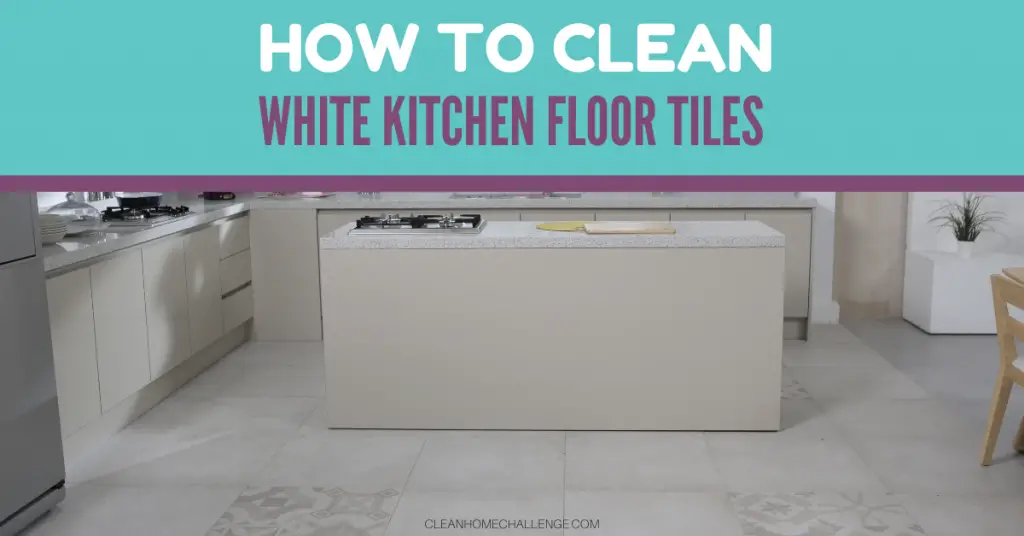THIS POST MAY CONTAIN AFFILIATE LINKS. PLEASE READ MY DISCLOSURE FOR MORE INFO.
White tiles are probably the most popular titles in both traditional as well as modern interiors.
They can look chic by themselves or combining with any other color, with probably the best combination being white and black tiles.
Traditionally, white tiles are used mainly in the bathroom. Nowadays, with the introduction and wider use of higher-end white tiles, they are also used in the living or dining room, as well as the kitchen.
There are mainly three types of white tiles –
- Marble and some other natural stones,
- Ceramic/porcelain,
- And innovative products such as White Crystal C1.
Even though they can improve the look of your home, they’re also very hard to clean. Especially in the kitchen which is a very high traffic area.
With so many things around, there’s always the danger of stains and dirt getting accumulated on white kitchen floor tiles.
However, you can fix this problem quite easily. By working on your cleaning routine and following a proper strategy.
In this article, you’ll learn what causes white kitchen floor tiles to get dirty, what materials you’ll need to clean the white tiles, how many types of white tiles there are and how to clean them, etc…
And then finally how to keep your white kitchen floor tiles clean for a long time without putting in too much effort.
Why Do White Tiles Get Dirty?
The color white is the building block of any color. You can add any color to it and it mixes with it. So, every time you’re working in your kitchen, and let’s say your feet are dirty, your tiles gets dirty as well.
Every time you leave food stains or leftovers in the kitchen, the tile gets its color as well.
You can’t be careless when you have a white tile installed on your kitchen floor.
Materials You’ll Need To Clean White Tiles:
- White vinegar mixed with one liter of hot water. (Only for ceramic or porcelain white tiles.)
- A spray bottle so you can spread the solution equally.
- Sponge.
- Microfibre cloth.
- A pH-neutral solution for white marble floor.
- Baking Soda (For Marble & Natural Stone)
Cleaning White Marble or Natural Stone Tiles of the Kitchen
White marbles or natural stones are very sensitive and can become extremely dirty very fast especially in a kitchen. One of the biggest reasons behind this is Iron Oxidation.
Iron oxidation is one of the most obvious reasons behind the yellowing of white marble. Iron is commonly found in various natural stones. When it is exposed to agents such as water, acids, or even bleach, the iron in the stone will oxidize, creating a yellow color as a result.
However, you can take certain steps to make sure your marble isn’t looking dirty from stains or iron oxidation while maintaining its proper white shine.
First of all, you need the sweep the floor and make it dust-free.
Dust particles on the marble floor can cause it to scratch ruining the texture of the kitchen marble floor.
Then take your microfiber cloth and make it wet in warm water. Then start wiping the marble floor with it.
Then take 2-3 spoons of baking soda with water and apply it on the surfaces where the marble is dirty and leave it for 1-2 hrs.
After that take a wet cloth and wipe the area again.
How To Maintain A White Marble Kitchen Floor?
- If you see stains, wipe them away quickly with a warm wet cloth. Don’t let it sit. White marbles are very sensitive surfaces. They’ll react very quickly to the stain.
- Only pick pH-neutral cleaners. Marbles don’t react well with acid. And their texture and look can be spoiled permanently if you use acid on the surface.
Read more on how to create an everlasting shine on your marble floors here.
Cleaning White Ceramic and Porcelain Kitchen Floor Tiles
One of the biggest reasons ceramic or porcelain floor tiles get dirty is because of the quality of the grout.
Grout is a substance mixed with cement, water, and sand.
Which the tiler uses to fit the tiles properly on the floor.
But if the grout isn’t cleaned properly after fitting it damages the quality of your tiles and also attracts a lot of stains and dirt.
Now, there are mostly 2 types of ceramic or porcelain tiles. Glazed and Unglazed. So, we’ll look at how to clean each below:

1. Unglazed flooring tile
Below are the simple tips to clean unglazed/unpolished flooring tiles.
- Vacuum-clean or sweep the flooring.
- Grab a bucket and make a mixture of hot water and your floor cleaner. Saturate the flooring with the hot water and floor cleaner and let them stay on the flooring for five to ten minutes. Don’t let tile cleaning agents dry on the floor. Likewise, for this process, you have to do it in little areas at a time.
- Scrub the floor with a rigid nylon-bristle broom. For the small, hard to reach areas, use a scrubbing brush.
- Wipe off the dirty cleaning water and rinse off the area of porcelain tile with clear and clean water using either a wet vacuum cleaner or a mop.
You may need to repeat the cleaning process if the unglazed porcelain tile is spotted to a greater extent.
2. Polished flooring tile
In the case of glazed or polished flooring tiles, the following instructions should be followed for common cleaning:
- Vacuum-clean or sweep debris from the flooring.
- Using a mop and bucket, make a mixture of 4 litres of hot water, to 1 cup of white vinegar, and mop over all your floors.
- Follow by another mop using only hot water.
- Carefully dry it to step up the glow and to forbid water stains. You can use a flat mop pad system to dry your tiles.
Safety Measures And Preventions With Ceramic/Porcelain Tiles
- Don’t apply any wax cleansing agents’ sealants or oil-based cleaning detergents
- Don’t apply cleaning agents which hold any colors or dyes on the unpolished tile.
- Place carpets at outside entrances to not allow the sand from being walked over onto the flooring tile.
- Don’t utilize the steel wool pads for tile cleaning, since the light steel portions could drive rust spots in the grout.
Keeping White Tiles in the Kitchen Cleaner For A Long Time
Following these useful tips will ensure that you can maintain and keep your kitchen floor tiles clean and free from dirt and bacteria:
The first thing you should focus on is cleaning the tiles daily.
This task is simple, and it will not take more than 15 minutes. Before mopping the floor with water, you should vacuum or brush it first. It’s an excellent method to keep debris and dirt from piling up on the tiles. You can also use a duster to brush the tiles. After that, you may mop the floor and wipe the floors with hot water.
It is better to completely dry out the tiles to prevent the formation of mildew. If your kitchen consists of heavy furniture made of metal, wood, plastic, or aluminum then you should place pads underneath their legs. This helps in preventing the tiles from getting scratches.
Since the kitchen is a high traffic area and you can always dirty it with your wet feet or dust accumulated from outside. So place a mat on the kitchen entrance to keep as much dirt as you can away from the white kitchen floor tile.
Apart from their daily wiping, it is good to mop these tiles with a solution made of water and vinegar once in a while.
In 4 litres of water, pour a cup of vinegar and then use it to mop your tiled floor. The gentle acidity of the vinegar will cause all the mildew to die.
Also, it is significant to note that you should avoid the use of other chemical agents for cleaning tiles because these agents cause these tiles to fade and also affect their texture.
Between each tile, there is a cemented space, known as grout. The grout of white tiles is usually white and it is also responsible for making your white kitchen floor tiles dirty. Clean it with hot water and an old toothbrush and get it sealed.
It is one of the foremost places where your kitchen tiles are going to get dirty.
So, be sure to seal it after you’ve properly cleaned it. Use silicone-based sealers to seal it.
And please note that when applying cleaning agents, ensure that you wash them thoroughly to eliminate chemical residues. Sometimes, residues are responsible for discoloration and dirt adherence.
Following these useful tips will ensure that you can maintain and keep your white kitchen floor tiles clean and free from dirt and bacteria. And keep your kitchen as good as new!
















